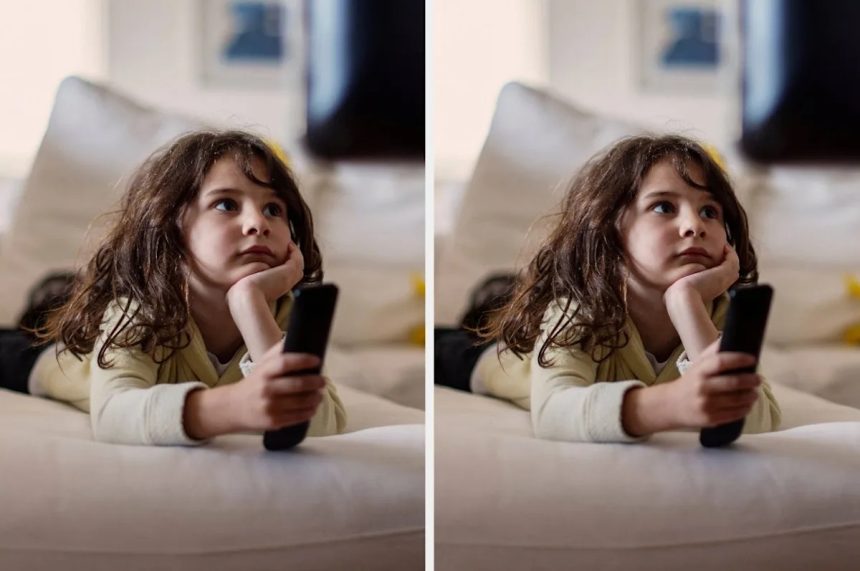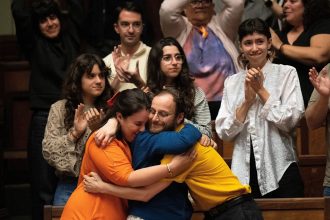What your kids see on popular children’s TV programs could teach them lasting lessons about what kind of leaders girls and boys can grow up to be.
Thanasis Zovoilis / Getty Images
According to a new study in Psychological Science, harmful gender biases continue to persist in TV programming for kids.
Researchers analyzed scripts from 98 children’s television programs in the US from 1960 to 2018, including classics like Scooby-Doo, Where Are You! (1970) and modern shows like SpongeBob SquarePants (2002), Dora the Explorer (2012), and The Powerpuff Girls (2016).

©Warner Bros/Courtesy Everett Collection
What they found was that gender stereotypes are at the core of children’s TV content. Troublingly, this pattern has not improved and has, in fact, remained consistent over 60 years.
“Gendered patterns in language are a much subtler form of bias — the part of the iceberg that’s hidden underwater — one likely to go unnoticed by audiences and creators alike,” the study’s lead author, Andrea Vial, told HuffPost.
The number of female characters in TV shows and movies has increased considerably, Vial noted, but what female characters on children’s TV shows get to do and say is still sending gendered messages to kids.

Disney Junior / Getty Images
Even creators with good intentions can perpetuate limiting beliefs about girls’ agency. “These linguistic biases may seem too subtle to matter. But they do matter, because they quietly shape children’s beliefs about the way the world works,” Vial said. Here’s how.
Female characters get relegated to passive “done-to” roles.
Researchers looked at over 2.7 million sentences in over 6,000 scripted episodes of TV. What they found was that when pronouns like “he” and words like “boy” would appear, they would often be in sentences where boys were agents or “doers.” In scripts, “male” words were associated with actions of achievement, money, power, and reward.
For example, the sentence “Never send a boy to do a man’s job” showed up in a 1964 episode of Bewitched and was coded by researchers to have the agentic category of “job” co-occurring with male words “boy” and “man.”

Ron Thal / TV Guide / Courtesy Everett Collection
But when pronouns like “she” and words like “girl” appeared, they would be in sentences where female characters were in a passive position.
Even shows from the 2000s had notable differences in boys being the “doers” rather than the “done-tos,” with shows like Curious George, Boy Meets World, Drake and Josh, Danny Phantom, and Phineas and Ferb, being standout examples.

©Nickelodeon Network/Courtesy Everett Collection
“For these shows, the syntactic male advantage was particularly stark,” Vial said. She noted that when boys are more likely to get seen as “doers,” this “sends kids the message that agency belongs more naturally to boys than to girls, even if no one explicitly intends to send that message.”
Gender equity researcher Amy Diehl also said this can teach children to assume harmful stereotypes about girls and boys.
“From a young age, children learn by categorizing. This is normal. When they watch television that shows boys generally ‘doing’ and girls generally being ‘done to,’ they unconsciously register the pattern,” Diehl said. “In this case, the pattern is a harmful stereotype, which may lead them to assume that girls are passive and boys are active.”

Thanasis Zovoilis / Getty Images
Why has there been so little progress with gender stereotypes in children’s TV?
Diehl said that one reason why there has not been more progress might be due to the writers in the room creating these storylines.
The study looked at TV shows written between 1960 and 2018, and in 2019, a separate Rutgers University study found that the people responsible for US and Canadian children’s television content are predominantly men. In the US, men are 80% of directors, 71% of show creators, and more than half of writers. Only 18% of episodes were written only by women, and only 25% were mixed-gender writing teams.

Marcus Chung / Getty Images
“‘Mixed-gender’ writing rooms are often dominated by white men with women being numerical tokens, meaning that women can have trouble getting their perspectives heard,” Diehl said.
“Although women’s place in society has changed a lot…since the 1960s, it’s not surprising that these changes are minimally reflected in the language of children’s media,” Vial said. “It would take a concerted effort by writers and producers, and attention to subtle linguistic biases like the ones we uncovered, to make meaningful change.”
Until this change takes place on screens, parents should be vigilant about monitoring what their children hear from TV.
In the study, researchers also found that words related to “home” and “family” were more often associated with “female” words.
For example, “She needs to stay in bed for a few days,” from a 2012 episode of My Little Pony: Friendship is Magic, was coded as containing a “home” category co-occurring with a female word (“she”).

©Hub Network/Courtesy Everett Collection
“This is another harmful stereotype that can lead children to assume that men belong in the workplace and women at home,” Diehl said. “Parents can interrupt these stereotypes by pointing them out and by seeking out shows that have more diversity in character roles.”
Families can also take these lessons offline and teach children to engage with people in non-stereotypical roles, such as by reading books about women in STEM or playing with toys traditionally associated with the opposite gender, Diehl suggested.

Eclipse_images / Getty Images
What this study underscores is that even the simple way we structure our sentences when speaking to children can teach limiting ideas about the roles girls and boys should have.
Vial said parents who try hard to teach their children a gender-inclusive outlook are often surprised to find that their kids “somehow still come to endorse gender-biased views and stereotypes. ‘Where did that come from?’” she said. “As our study demonstrates, they may be picking it up from a seemingly innocent source: age-appropriate television content that, at first blush, may not even seem biased.”
This article originally appeared on HuffPost.









